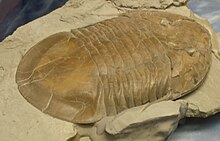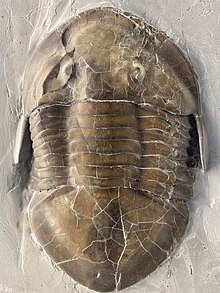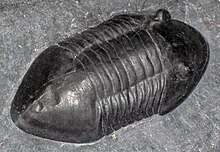|
Isotelus
Isotelus is a genus of asaphid trilobites from the Middle and Late Ordovician Period, fairly common in the northeastern United States, northwest Manitoba, southwestern Quebec and southeastern Ontario. PaleobiologySpecimens of the species I. rex were found in the Churchill River Group, in sediments that were once a warm, rocky, shallow subtidal zone along an Ordovician shoreline. During the Late Ordovician, this area would have been at the equator.[1] Isotelus, like all asaphid trilobites, did not survive past the Ordovician-Silurian mass extinction event. Asaphidae, like all other derived asaphide trilobite families, are inferred to have a unique and lengthy planktonic larval phase, only becoming benthic like adults after metamorphosis. The first instar larvae of Isotelus for instance were just 0.6 mm long, becoming benthic and adult-like at 8-10 mm long. As there is a wide diversity of adult morphology in the aforementioned trilobite families, this tiny planktonic larval phase that they share may be the link to their extinction. Most trilobites with this life history strategy lived in warm, low latitude waters, in which planktonic, non-adult like larvae may be ideal at surviving in. During the Ordovician-Silurian extinction event, the widespread onset of cold water conditions and anoxia may have instead favoured species that produced small numbers of large eggs, from which hatched larvae that were already benthic and adult-like in morphology.[1] The I. rex holotype preserves two small clusters of small, round, shallow pits on the head and thorax. These may have been the attachment points of soft bodied sessile epibionts.[1] Gigantism The mostly complete holotype specimen of Isotelus rex, from Churchill River Group, Churchill, Manitoba, is the largest complete trilobite ever found. Discovered by Dave Rudkin (Royal Ontario Museum), Robert Elias (University of Manitoba), Graham Young (Manitoba Museum) and Edward Dobrzanske (Manitoba Museum) in 1999, it measures 720 millimetres (28 in) in length, 400 millimetres (16 in) in maximum width (across the cephalon) and 70 millimetres (3 in) in maximum height (at the posterior midpoint of the cephalon).[2][3][4] It was probably exceeded in size only by Hungioides bohemicus, in which the specimens probably exceeding I. rex in size are only known from partial remains.[5]  Found in Manitoba, which was equatorial during the Ordovician, I. rex is a dramatic example of low-latitude gigantism, contrasting with many modern marine benthic arthropods which adhere to Bergmann's rule of polar gigantism. Similarly, most other giant trilobites also lived in shallow tropical or mid latitude waters (eg, Terataspis, Cambropallas, Acadoparadoxides), although a few like Uralichas were from cold, high-latitude waters.[1] Species A number of species have been described:
Many specimens have been found in Ohio, where Isotelus is the State Invertebrate Fossil.[6][7] References
|
||||||||||||||||||||||||||
Portal di Ensiklopedia Dunia

